Comparison Between Early and Late 21stC Phytoplankton Biomass and Dimethylsulfide Flux in the Subantarctic Southern Ocean
QU Bo, Albert J. GABRIC, JIANG Limei, and LI Chunyue
Comparison Between Early and Late 21stC Phytoplankton Biomass and Dimethylsulfide Flux in the Subantarctic Southern Ocean
QU Bo1), *, Albert J. GABRIC2), JIANG Limei3), and LI Chunyue4)
1) School of Science, Nantong University, Nantong 226019, China 2) School of Environment and Science, Griffith University, Nathan Qld 4111, Australia 3) Nantong Chong Chuan School, Nantong 226000, China 4) Marketing, Thermo Fisher Scientific, Shanghai 201206, China
Time-series of chlorophyll-(CHL), a proxy for phytoplankton biomass, and various satellite-derived climate indicators are compared in a region of the Subantarctic Southern Ocean (40˚-60˚S, 110˚-140˚E) for years 2012-2014. CHL reached a minimum in winter (June) and a maximum in late summer (early February). Zonal mean CHL decreased towards the south. Mean sea surface temperature (SST) ranged between 8℃ and 15℃ and peaked in late February. CHL and SST were positively correlated from March to June, negatively correlated from July to September. CHL and wind speed (WIND) were negatively correlated with peak WIND occurred in winter. Wind direction (WIRD) was mostly in the southwest to westerly direction. The Antarctic Oscillation index (AAO) and CHL were negatively correlated (=−0.58), indicating that as synoptic wind systems move southwards, CHL increases, and conversely when wind systems move northwards, CHL decreases. A genetic algorithm is used to calibrate the biogeochemical DMS model’s key parameters. Under 4×CO2(after year 2100) Regional mean SST increases 12%-17%, WIND increases 1.2ms−1, Cloud Cover increases 4.8% and mixed layer depth (MLD) decreases 48m. The annual CHL increases 6.3%.The annual mean DMS flux increase 25.2%, increases 37% from day 1 to day 280 and decrease 3% from day 288 to day 360. The general increase of DMS flux under 4×CO2conditions indicates the Subantarctic regional climate would be affected by changes in the DMS flux, with the potential for a cooling effect in the austral summer and autumn.
wind speed; phytoplankton; dimethylsulfide flux; climate change; subantarctic Southern Ocean
1 Introduction
Anthropogenic global warming may be mitigated by biogeochemical feedbacks such as the one involving ma- rine biogenic emissions of dimethylsulfide proposed by Charlson. (1987). The so-called CLAW hypothesis involves the creation of sulfate aerosol from the oxidation of gaseous DMS, which could alter the Earth’s radiative budget both directly by scattering solar energy and indi- recttly by affecting cloud albedo and lifetime (Kloster., 2006). The emission of DMS involves the intracellu- lar production of its precursor dimethylsulfonium propionate (DMSP) by phytoplankton, and is affected by a variety of food web processes (Simó, 2001).
The sea-to-air flux of DMS is a function of wind speed, sea surface temperature and DMS seawater concentration. DMS concentration in sea water is controlled by a num- ber of processes, including microbial consumption and photolysis. Subantarctic winds and ocean currents are also influenced by climate variability as indicated by the Antarctic Oscillation index (AAO) and other climate indices. Hence the regional DMS flux is determined by a complex set of interactions and possible feedbacks be- tween marine biogeochemistry and climate.
1.1 Regional Currents
The Subantarctic Southern Ocean (SSO) includes regions of the Indian, Atlantic and Pacific Oceans north of the polar front. The Antarctic Circumpolar Current (ACC) is an ocean current that flows from west to east and traverses our study region. It is the world’s largest ocean current linking all the major ocean basins (Barker., 2007) and influences both the ecology and biogeography of the SSO (O’Hara., 2008). When cold Antarctic waters meet the warmer Subantarctic waters, they create an upwelling nutrient-rich zone called the Antarctic Convergence. The upwelling cold water takes up a large amo- unt of excess heat from the atmosphere (Manabe., 1991). The upwelling water can also take up a large amount of anthropogenic CO2, as it has not been in contact with the atmosphere (Mikaloff Fletcher., 2006). The upwelling water contains nutrients from the deep ocean from the composition of organic matter for centuries (Frölicher., 2015). This region is characterized by high levels primary production that supports secondary producers such as copepods, krill and other species. The ACC is accompanied by three fronts in the north-south direction: the Subantarctic front (SAF), the Polar front (PF) and the Southern ACC front (SACCF) (Fig.1) (Sallée., 2008). Ritoul and Trull (2001) suggested that near surface waters spread from south to north across the SAF, supplying cool, fresh, nutrient-rich water further north. The trends in the Antarctic Oscillation have been hypothesized to account for an increase in the transport of ACC over the past two decades (Barker, 2007).

Fig.1 The Antarctic Circumpolar Current (ACC) including three fronts in the north-south direction: the subantarctic front (SAF), the polar front (PF) and the southern ACC front (SACCF). The current directions are indicated by red arrows. Study region is also indicated (40˚-60˚S, 110˚-140˚E).
1.2 Wind Speed
Winds that drive the Antarctic Circumpolar Current (ACC) have increased in the past 50 years and shifted southward (Marshall, 2003). Stronger winds can result in increased vertical mixing in waters of the SSO (Bowie., 2011). Changes in vertical mixing can affect nutrient supply causing changes in surface plankton composition and local biogeochemical cycles. Negative correlations between WIND and SST have been noted, as stronger WIND can cause increased evaporation and increased upwelling. Increased evaporation can result in colder SST. Fitch and Moore (2007) note that stronger wind forcing will break down vertical stratification, and lead to deep mixed layers, with light limitation and the potential for reduced phytoplankton growth rate.
1.3 Phytoplankton Blooms
The SSO is a high-nitrate and low-chlorophyll (HNLC) region (Banse, 1996). Phytoplankton biomass displays a decreasing trend from north to south from subantarctic zone to the Polar Frontal Zone (Boyer, 1994). Phytoplankton blooms are limited by irradiance in the austral spring and by biologically available iron in the summer (Miller, 2004). Relatively higher winds caused water deep mixing, benefits phytoplankton blooms development where light levels are more elevated in upper ocean (Montes-Hugo and Yuan, 2012). However, there is an inverse relation between WIND and bloom occurrence, with blooms largely suppressed at high wind speeds (Fitch and More, 2007).
The influence of various climate indicators on phyto- plankton biomass in Subantarctic Ocean is examined in this paper, including WIND, Antarctic Oscillation (AAO). The impact on DMS flux assessments is compared by employing a DMS model forced by a global climate model. The implications for 21stC climate shifts in the Subantarctic Southern Ocean are discussed.
2 Data and Methods
Our analysis is focused on a region of Subantarctic Southern Ocean (SSO), south of Australia (40˚S-60˚S, 110˚E-140˚E) (Fig.1), with data for the period 2012-2014. CHL data was retrieved from Aqua archive, 8-day, 4-km, level 3, mapped chlorophyll-(CHL) global data (http://oceandata.sci.gsfc.nasa.gov/MODISA/Mapped/). The SeaDAS 6.4 software is used to retrieve regional data from the global database (seadas.gsfc.nasa.gov/). Mean values for each subset (1˚×1˚) grid cell are calculated first, with missing values excluded during the austral winter. Wind speed (WIND) and direction (WIRD), and sea surface temperature (SST) were obtained from WindSat Polarimetric Radiometer within Remote Sensing System (ftp://ftp.remss.com/windsat/bmaps_v07.0.1/weeks/). Mixed layer depth (MLD) data is retrieved from Argo Mixed Layers (http://mixedlayer.ucsd.edu/). Data on the Antarctic Oscillation index (AAO) is obtained from http:// www.cpc.ncep.noaa.gov/products/precip/CWlink/daily_ ao_index/aao/aao.shtml.
The R software package is used to re-sample the wind data to the (1˚×1˚) grid. Mean values of WIND and WIRD on each (1˚×1˚) grid are calculated from the 0.25˚×0.25˚ grid. The analysis is done in 5-degree zonal bands. The weekly WIRD at 10m for all weather conditions was derived using the algorithm given in Meissner and Wentz (2009) with data retrieving under rainy conditions. Any missing values are excluded from mean value calculations. EViews (Pang, 2006) statistical software is used for correlation and lagged regression analysis. R software is used to do the multi-variable regression analysis. Because the relationships between CHL and other factors may change with time, the time series needs to be checked for stationarity using the unit root test. The Akaike info criterion and Schwarz criterion are used for time lagged regression analysis. The Granger Causal Relation Test is used to test the dominant factor between two variables. Multivariate regression analysis is also employed.
3 Results
3.1 CHL Mean Concentration
The mean CHL time series for the period 2012-2014 is shown in Fig.2, which shows interannual variability is lower in winter and higher in summer. The zonal mean CHL had strong decreased trend towards the south (not shown in figure). The 8-day running mean CHL time series for five-degree zonal bands is shown in Fig.3. There are differences in the magnitude and timing of the peak CHL with the higher peaks achieved in the northern sections.

Fig.2 The 8-day running mean of CHL for year 2012-2014 in the study region (40˚-60˚S, 110˚-140˚E). Bars indicate standard deviations.
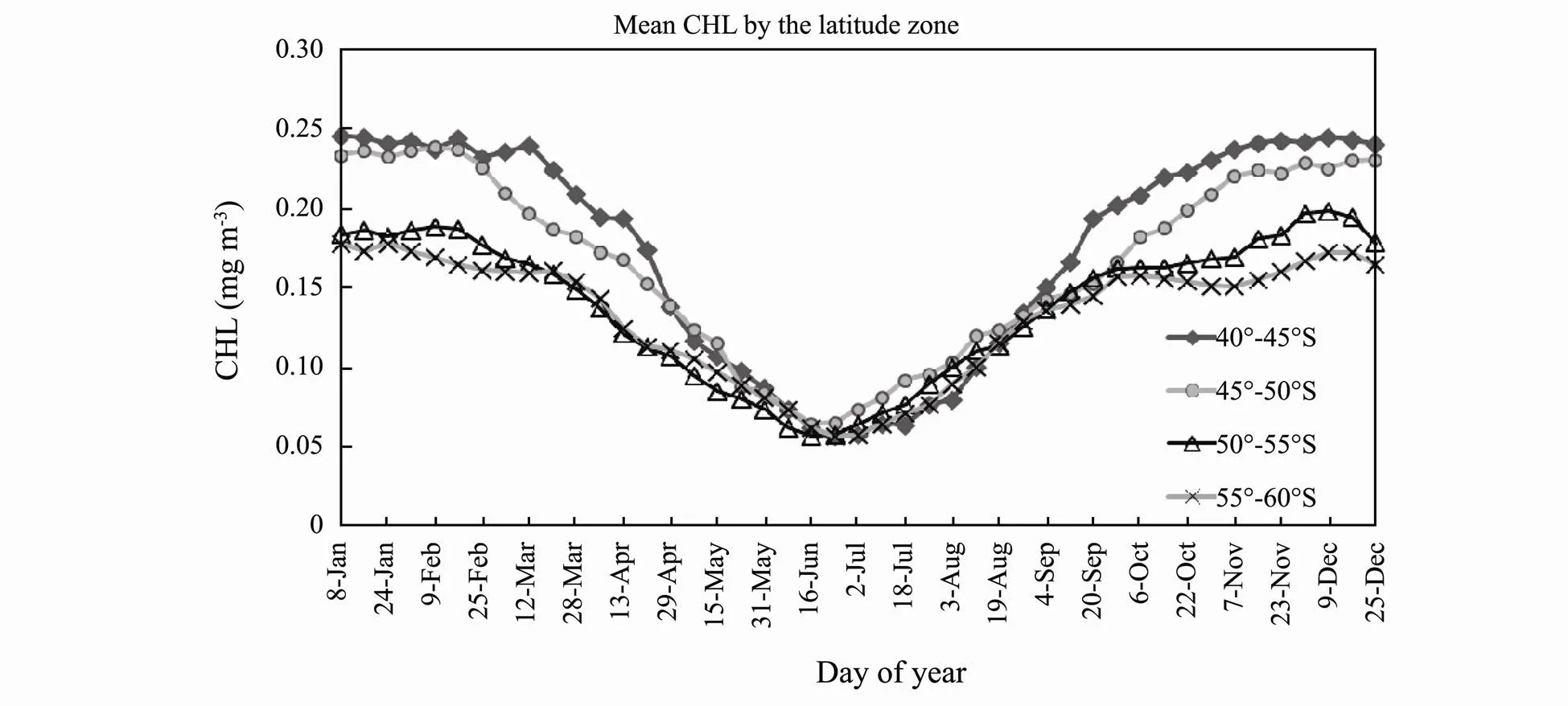
Fig.3 The 8-day running mean CHL time series in five-degree zonal bands in the study region (40˚-60˚S, 110˚-140˚E).
3.2 Wind Speed and Direction
Annual average WIND was around 10ms−1and slightly elevated in the austral winter (July-September) (Fig.4). There was a drop from April to June. The peak WIND occurred around day 217 (mid-July). WIND was higher in the north of the region (Fig.6). It was noted that wind speeds were higher in the west and lower in the east of the study region.
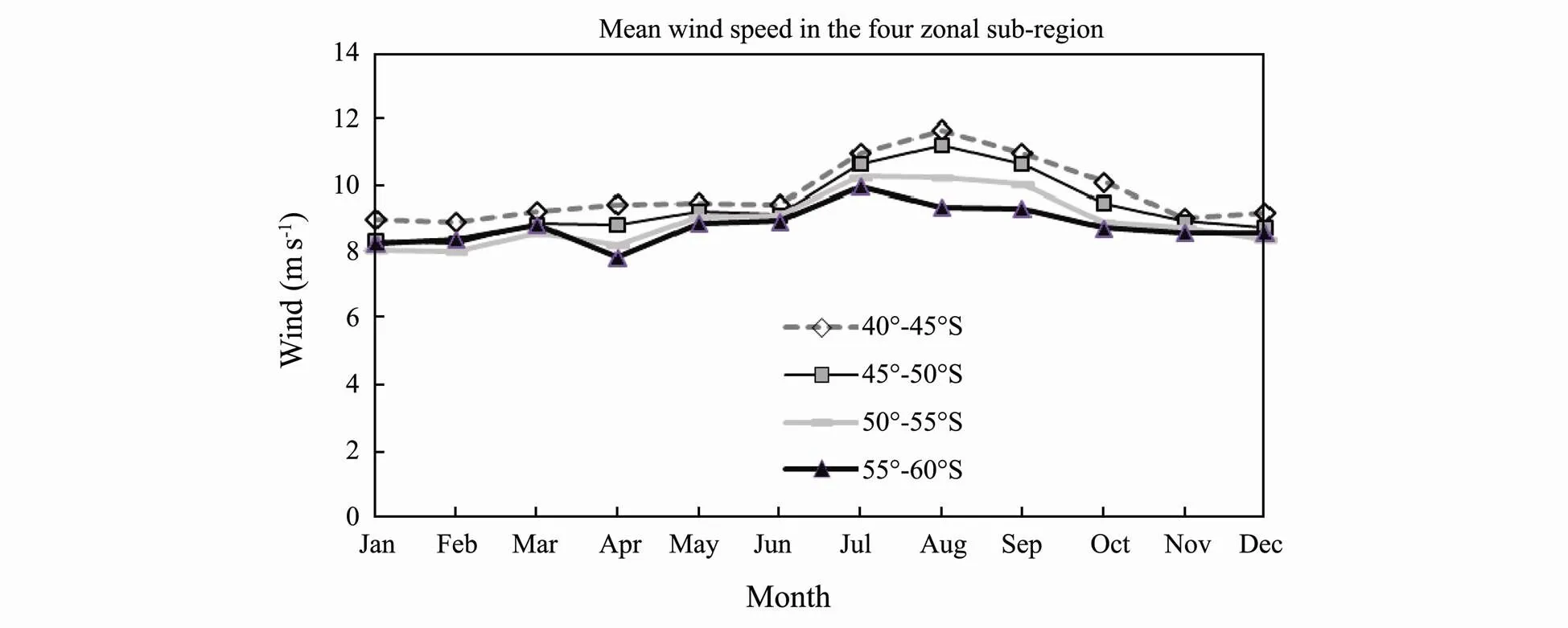
Fig.4 Monthly mean wind speed for the 3 years (2012-2014) in 5-degree zones for the study region.
3.3 Forcings and Their Relationships
3.3.1 SST and CHL
The peak SST occurred in late February (Fig.5). The minimum SST occurred in later September. SST decreased towards the south of the region. From March to June, CHL and SST were positively correlated; from July to September, CHL and SST were negatively correlated; from October to January or February in next year, CHL and SST were positively correlated again. There was 40 days time lag between CHL and SST with CHL ahead. If we shift SST 40 days ahead, the correlation between CHL and SST increased from 0.24 to 0.70.
3.3.2 CHL, WIND and MLD
WIND reached a peak during late autumn (August to September) (Fig.6). The increased WIND in winter mixes nutrients into the upper layer, hence stimulating phytoplankton growth in spring. The summer CHL was more influenced by light and nutrients, and not WIND (Qu., 2018). CHL reached a seasonal peak in Feb- ruary or March. From middle of Feburary to middle of June, the WIND generally steady increased, and CHL displayed a decreasing trend due to light limitation and increasing MLD (Fig.6). MLD had winter high and summer low trends with range between 44m-91m. CHL and WIND had a correlation coefficient −0.63 in summer seasons and decreasing to −0.16 in autumn and winter seasons. The Pearson correlation test shows the correlation between CHL and WIND is around −0.6 for the whole year within year 2012 and 2014. If shift WIND 2 months ahead, CHL and WIND would have negative correlation of −8.4. CHL and MLD had negative correlation of −0.9 for the 3 years with no time lag. With the increase of MLD from middle of January to middle of June, CHL would decrease accordingly. With the decrease of MLD from middle of June to middle of January, CHL would increase accordingly.

Fig.5 Regional means of SST and CHL in the study region.
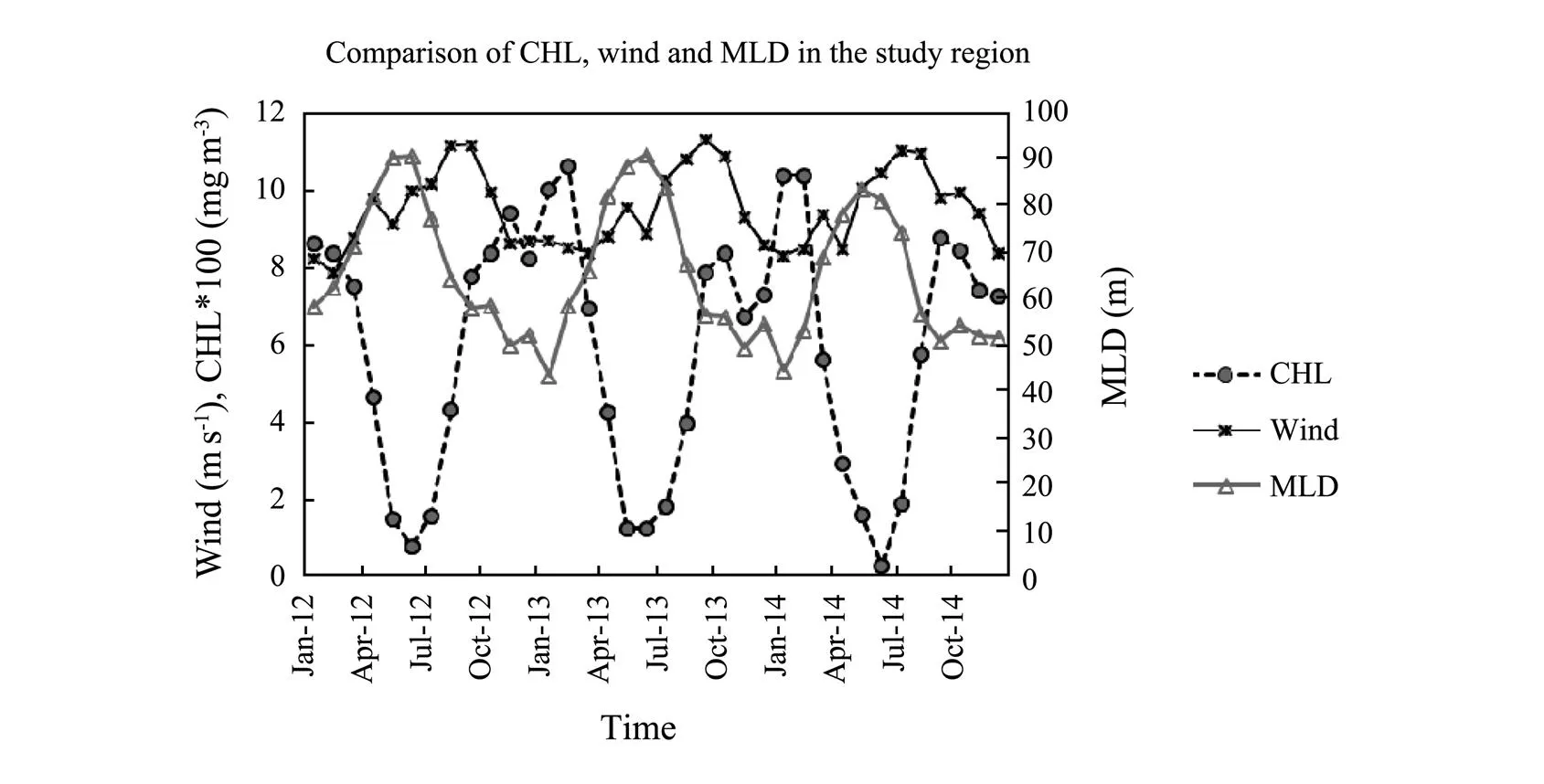
Fig.6 Mean time series of CHL, WIND and MLD in the study region from year 2012-2014.
3.3.3 The relationships among AAO, MLD and CHL
The Antarctic Oscillation (AAO) (or Southern Annular Mode) is a low-frequency mode of atmospheric variability in the southern hemisphere. It is defined as a belt ofwesterly winds or low pressure surrounding Antarctica which moves north or south as depending on the sign of the mode of variability (Liu., 2012). In its positive phase, the westerly wind belt contracts poleward, while in the negative phase the belt moves towards the equator. The mean CHL and AAO time series is shown in Fig.7a. In general, there is a significant negative correlation between CHL and AAO. When AAO was lagged by 3 months they have negative correlations of −0.24 (−0.42 for year 2012, −0.07 for year 2013 and −0.34 for year 2014). If shifted AAO three months ahead, the correlations between CHL and AAO would be increased to 0.6. The negative correlation indicates when wind moves towards the equator (northwards), CHL would likely increase and when wind moves towards Antarctic (southwards), CHL would likely decrease. AAO and CHL had correlations 0.58 and −0.89 respectively in the first half year of 2012 and 2014. That indicate that CHL would decrease in the first half year of 2012 due to the positive correlation with AAO, wind directions would change towards equator. In the first half year of 2014, CHL would increase due to the negative correlation with AAO. Wind direction would move towards SO. However, in general, the relationship of AAO and CHL is negative. Granger Causality analysis shows AAO influences CHL. Positive AAO in summer and autumn indicates the wind directions usually move southwards and CHL would decrease. Decreased AAO would cause CHL increase (for the periods of August to November 2012, March to September 2013 and May to September 2014) (Fig.7a).

Fig.7 Mean time series of CHL and AAO in the study region from year 2012-2014. Zero line of AAO is indicated in the figure.
The correlation coefficient between MLD and AAO is 0.37 with 2 months time lag (Fig.7b). If shift MLD two months ahead, the correlation would improved to 0.6. AAO influenced MLD is obviously seen.
The Pearson correlation coefficients show that the general trends are negative for CHL and AAO (Table 1). But the first half year in year 2012 and later half year of 2014 were all positive. The later half year of 2012 and early half year of 2014 had more distingtive negative correlations (up to −0.9). The coefficients in Table 1 are significant.

Table 1 The Pearson correlations between CHL and AAO
4 Implications for DMS Flux
4.1 Model Simulation of Future DMS Flux
The biogenic compound dimethylsulfide (DMS) is the most important source of reduced sulfur to the atmosphere, and its production is closely connected to the dynamics of the marine food web. Once ventilated to the atmosphere, it can be a major source of cloud condensation nuclei (CCN) in the unpolluted marine atmosphere (Leck and Bigg, 2005). DMS flux is a function of the transfer velocity and DMS seawater concentration. The transfer velocity depends on the WIND and SST.
The DMS model is a nitrogen-based ecosystem model with a sulfur sub-model described by Gabric. (Gab- ric., 1999) and is given by the 5 system coupled equations (Qu., 2016, 2017). The nitrogen and sulfur models are decoupled. Hence, model parameters can be calibrated separately for both nitrogen and sulfur based models.
The DMS sea-air flux is calculated by the following equation (Liss and Merlivat, 1986):

The transfer velocitykis defined by Gabric. (1995).
Monthly mean satellite and meteorological data on SST, WIND, CLD and MLD were compiled for the 3-year study period prior to the DMS model calibration. The key model parameters are calibrated using genetic algorithm (GA) optimization method. During calibration, a fitness function was calculated using a chi-square function that minimizes the difference between satellite CHL data and model simulated CHL data. After the CHL calibration for the 6 most sensitive parameters, the 5 most sensitive parameters in the sulfur sub-model were then calibrated. The previously calibrated CHL sub-model parameters were used in the sulfur sub-model calibration. However, the observation data is different. The monthly mean DMS observed data is based on Fig.4 in Gabric. (2003). This is the best available estimates we could find in the study region. The detailed method is described in Qu. (2016). DMS concentrations in the study region are then obtained by re-running the DMS model using the calibrated parameter values.

Fig.8 Comparison of DMS monthly mean profile in the study region. The base data is from Gabric et al. (2003).
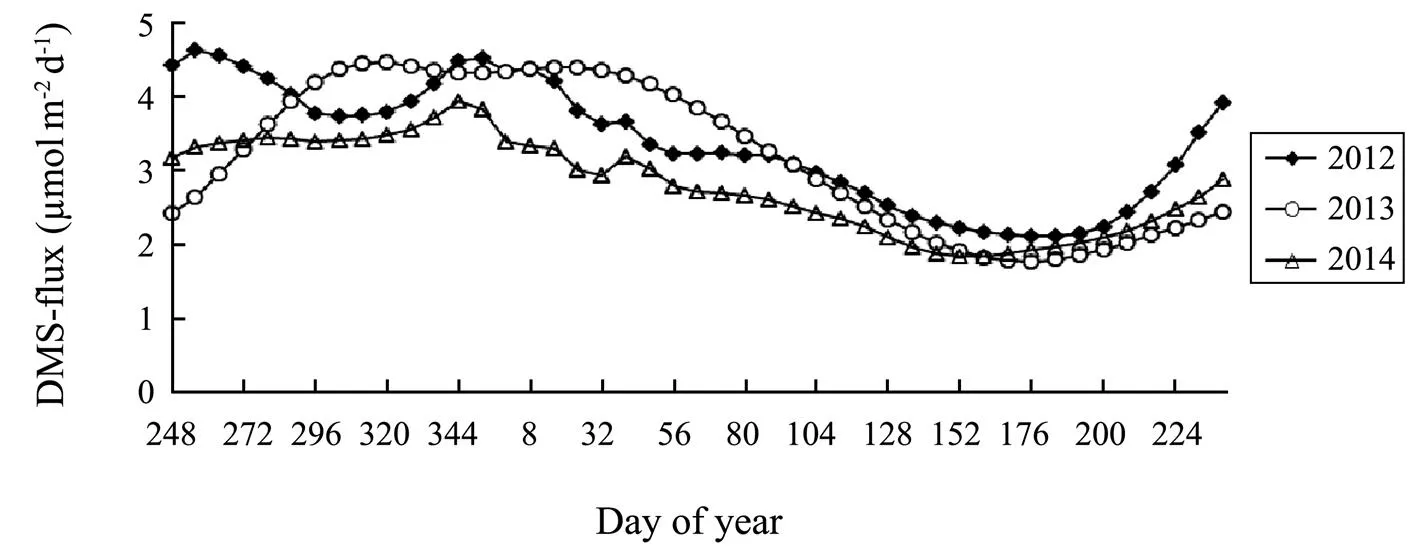
Fig.9 Simulated DMS flux comparisons for year 2012-2014 in the study region.

The simulated time series of mean DMS flux for each year (2012-2014) is shown in Fig.9. Note that the simulation starting day is day 248 which is in August (winter time). Peak DMS flux occurred between December and January, apart from year 2013 where elevated flux was simulated from October to end of January. The simulated DMS flux reached a minimum in June for all 3 years.
4.2 Late 21st DMS Flux Projection
The Coupled Model Intercomparison Project Phase 5 archive (CMIP5) (http://pcmdi9.llnl.gov/cmip5/forcing. html) is used to provide forcings under the warming scenarios. Software OpeNDAP is used to obtain the forcing data in AMIP for both 1×CO2(year 2008) and 4×CO2conditions (after year 2100).
The input annual mean forcing data are shown in Fig.10. SST increases 17% from Jan-May, and then decrease 12.8% after May. WIND increases 1.16ms−1. Cloud cover increases 4.84%. MLD decreases 48m on average. MLD decreases from spring months with maximum drop in Sep- tember (reduces 121m) by 4×CO2comparing to1×CO2.
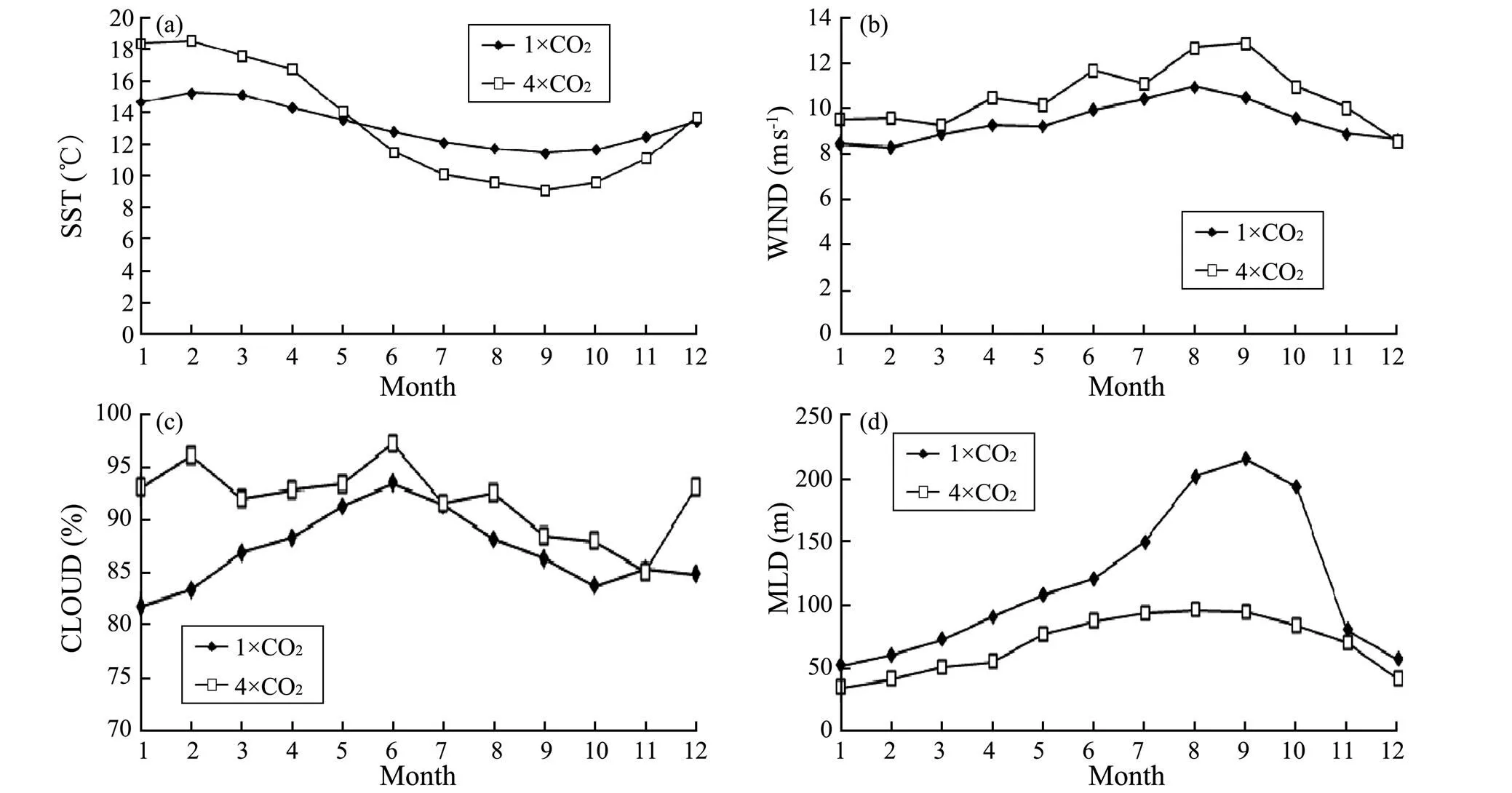
Fig.10 Comparisons of monthly mean SST, Cloud Cover, WIND and MLD for 1×CO2 and 4×CO2.

Fig.11 Comparison of monthly mean for (a) DMS concentration (b) Transfer velocity kwand (c) DMS flux for 1×CO2 and 4×CO2.
Previous researches in the Subantarctic Southern Ocean are A (40˚-50˚S, 125˚-145˚E) (Gabric., 1998) and B (60˚-65˚S, 125˚-140˚E) (Gabric., 2003). Gabric. suggested that DMS flux increases more than 5% (for case A) in 2×CO2and increases 33% (for case B) in 3×CO2. Those would lead to radiation forcing changes on −0.29Wm−2(for case A) and −1.7±0.5Wm−2(for case B). Our research suggests that WIND, nitrogen, MLD, SST and other forcings are all the causes of phytoplankton blooms, hence are also the causes of the ventilation of DMS flux. By 4×CO2, DMS concentration would increase by 54.6% and transfer velocity would increase by 61.8% (Figs.11(a), (b)). Notice that the day of year in Fig.11 starts from winter (day 248). The transfer velocity reaches to the peak during December to January. However, in our Subantarctic region (40˚-60˚S, 120˚-140˚E), DMS flux increases 25.2% under 4×CO2conditions. Annual integrated DMS flux mainly increases 36.7% from January to September and increases 2.8% from October to December (Fig.11(c)).
DMS flux reduces from 1×CO2to 4×CO2during day 288 to day 360 (Fig.12). The reasons could be due to the decreases of transfer velocity and decreases of CHL during the period, although DMS increases during the period (Fig.12).
Table 2 lists the increase rates of CHL, DMS, DMSP, Z, DMS flux andkfrom 1×CO2to 4×CO2. From 1×CO2to 4×CO2, the rates are generally increased, with DMS, zooplankton (Z) and transfer velocitykincreased more than 50%.
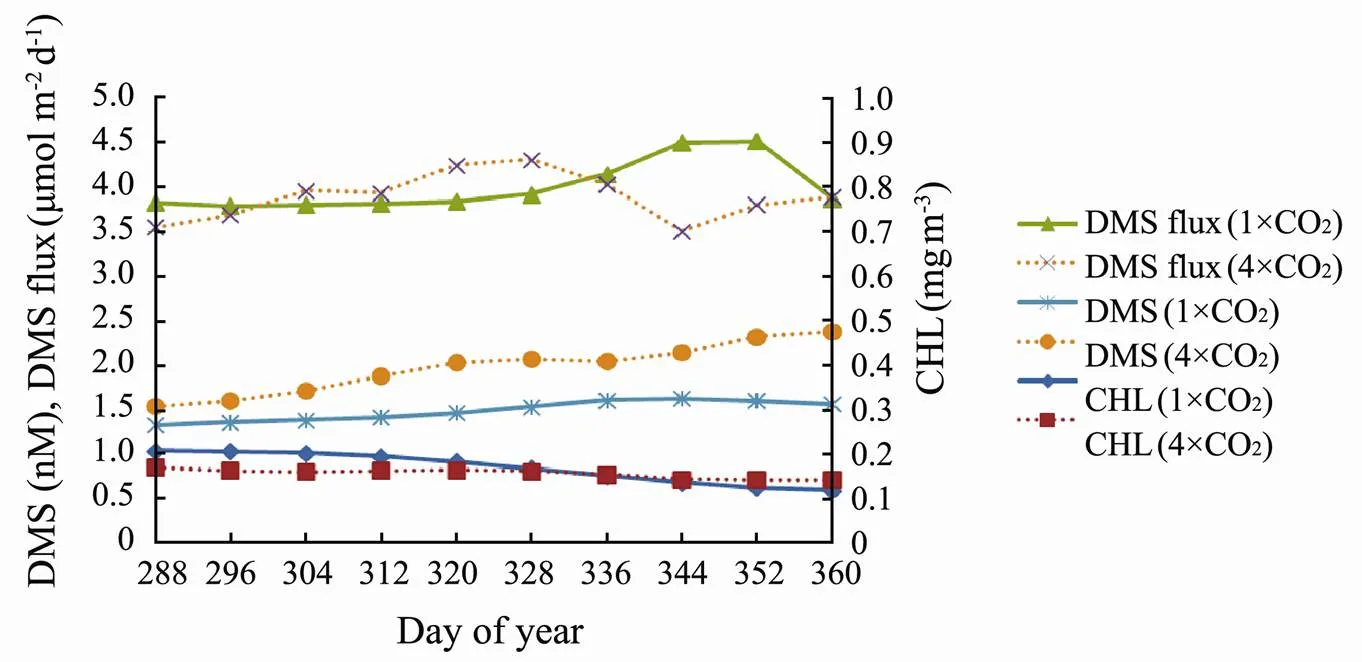
Fig.12 CHL, DMS and DMS flux comparisons for the decreased period of DMS flux (day 289-360) from 1×CO2 and 4×CO2.

Table 2 Changes in key state variables from 1×CO2 and 4×CO2
5 Discussion and Conclusion
Time-series of chlorophyll-(CHL) and various satellite-derived climate indicators are compared in a region of the Subantarctic Southern Ocean (40˚-60˚S, 110˚-140˚E) for years 2012-2014. A range of statistical analyses are conducted to examine the relationship between CHL and the various climate variables. Pearson correlation analysis, regression analysis, Grainger Causality test and lag regressions are used for the statistical analysis.
Our results show that CHL was lower in winter and higher in summer, with its peak in early February and reached to valley in end of May or early June. 2013 had higher CHL and 2012 had lower CHL. CHL decreased from north to south. WIND was slightly higher in winter and lower in summer with average speed around 10ms−1. WIND was higher in the west and lower in the east. Wind directions were normally on the southwest to westerly directions. CHL and WIND were mainly negatively correlated. Increased winter WIND would cause upper layer water body gain more nutrients, lead to increase of CHL. The decreased WIND in spring would help the deve- lopment of CHL. WIND had less influence on CHL during summer. With the increased water temperature, seasonal thermocline prevented supplement of nutrients, those would lead CHL deccrease in summer. Grainger causality test shows WIND affected CHL.
AAO and CHL had significant negative correlations. When the wind moves northwards towards Equator, CHL would likely decrease; when the wind moves southwards towards Antarctic centre, CHL would likely increase.
A biogeochemical model was used to simulate the change in DMS flux under warming. CMIP5 is used to retrieve the regional forcing data for 1×CO2and 4×CO2conditions (Qu., 2017). Genetic algorithm is used to calibrate DMS model key parameters, in order to get the different region’s DMS and DMS flux (Qu., 2016). The CMIP5 data shows that, by the end of 2100 (4×CO2), regional SST increases 17% before May and decreases 12.8% after May. WIND increases 1.16ms−1, Cloud Co- ver increases 4.84% and MLD decreases 48m on average.
Although CHL only increases 6.3%, the regional DMS concentration increases 54.6%, DMS flux increases 25.2% under 4×CO2conditions. DMS flux increases from January to September (with rate of 36.7%) and decreases from October to December (with rate of 2.8%). Transfer velocity increases by 61.8%. The simulation results could be inaccurate due to lacking of observed DMS data for calibrating the model parameters. However, it is an indication that with the wind speed increases in the future, DMS flux would increase. CHL would be influenced by wind, but the increased trends are not significant. The results are valuable for the Subantarctic ecosystem researchers.
Our results may under-estimate the DMS concentration in the study region due to the limited observed DMS data for calibrations. A recent study by Jarnikova and Tortell (2016) pointed that the most recent global DMS climatology does not include a growing number of high-reso- lution surface measurements in SO waters. They found that the region of the Subantarctic Front (on latitude 51˚-52˚S) had most strong DMS sea-air fluxes due to the very strong persistent winds in this region. New research found extreme spikes in DMS flux in Ryder Bay, West Antarctic Peninsula coastal zone is extremely high (up to 968µmolm−2d−1) over a short timescales (Webb., 2019). They found the total flux of DMS-sulfur from the austral Polar province was 1.1Tg sulfur per year, which is more than double of the figure suggested by the most recent DMS climatologists.
The mean tendency of DMS increases in the SO with summer time (December to February) much higher than November. The high DMS concentrations would only be spotted by using refined grid. Our results would be very much under predicted according to their refined grid results. The tendency of DMS flux would be increase in some extend, this implied the future climate warming would be offset by DMS flux emission much more. The DMS measurements in polar regions (including Suban- tarctic Southern Ocean) are urgently needed for the more accurate simulations under future warming.
There is a big debate on how much the increase of DMS flux would offset the greenhouse warming. Recent research about SO focused on the upwelling water caused taking up large amount of anthropogenic CO2. The SO south of 30˚S accounts for 43% of the global anthropo- genic CO2uptaken from the atmosphere, while only covering 30% of the global ocean surface area (Frölicher., 2015). Under the high wind speeds, this part of water has the potential to take up large amount of anthropogenic CO2. The accelerating of SO overturn could be caused by a poleward intensification of the westerly winds due to increasing greenhouse gas concentrations and polar stra- tospheric ozone depletion (Waugh., 2013). By comparing with multiple CMIP5 models for the period 1861-2005, Frölicher. (2015) found that the domi- nante modeled anthropogenic CO2and heat uptake are in south of 30˚S, mainly focused on 40˚-60˚S. While SO plays a central role in slowing the rate of global warming through uptake of anthropogenic CO2and heat, due to its distinct dynamical regime. Our study region is within the main heat uptake region (with maximum at around 45˚S). In this region, anthropogenic CO2penetrates to greater depths in a relatively wide latitudinal band. The non- significant increase of DMS flux in our study region for the next 100 years (by 4×CO2) could be caused by the warming, freshening, and slowdown of Subantarctic bottom water formation due to heat up taken (Purkey, 2012). There is a northward excess heat transport across the equator. The Subantarctic ecosystem would be gradually changed once the ocean uptake of anthropogenic CO2and heat to a certain saturation level.
Acknowledgements
We gratefully acknowledge the NASA Ocean Biology Processing Group and Goddard Space Flight Center of SeaWiFS Project Group for providing MODIS CHL data (Aqua, Level 3, 4-km, 8-day, mapped) data, and the NA- SA Web SeaDAS development group for providing Ocean Colour SeaDAS Software for regional CHL data and image retrieval. Acknowledgement should also go to NOAA NCEP EMC CMB GLOBAL Reyn-SmithOIv2 for providing sea-ice concentration data. We thank the Naval Research Laboratory Remote Sensing Division, the Naval Center for Space Technology, and the National Polar-Orbiting Operational Environmental Satellite System (NPOESS) Integrated Program Office (IPO) for providing the WindSat Polarimetric Radiometer global satellite-based WIND, WIRD, SST, as well as the MATLAB programming for retrieving the regional data. Thanks to Dr. Xiaofan Duan and Dr. Yangyang Li for their AAO and SST data retrieving and calculations. Finally, we gratefully acknowledge the National Natural Science Foundation of China (Nos. 41276097 and 11701298) for providing research funding for this project.
Banse, K., 1996. Low seasonality of low concentrations of surface chlorophyll in the subantarctic water ring: Under- water irradiance, iron, or grazing?, 37: 241-291.
Barker, P. F., Filippelli, G. M., Florindo, F., Martin, E. E., and Scher, H. D., 2007. Onset and role of the Antarctic Circum- polar Current., 54: 2388-2398.
Bowie, A. R., Brian Griffiths, F., Dehairs, F., and Trull, T. W., 2011. Oceanography of the subantarctic and polar frontal zones south of Australia during summer: Setting for the SAZ-sense study., 58: 2059-2070.
Boyer, T. P. A. S. L., 1994. Quality control and processing of historical temperature, salinity and oxygen data. NOAA Technical Report NESDIS 81.
Fitch, D. T., and More, J. K., 2007. Wind speed influence on phytoplankton bloom dynamics in the Southern Ocean Mar- ginal Ice Zone.,112 (C8): C08006.
Frölicher, T. L., Sarmiento, J. L., Paynter, D. J., Dunne, J. P., Krasting, J. P., and Winton, M., 2015. Dominance of the Southern Ocean in anthropogenic carbon and heat uptake in CMIP5 Models., 28: 862-886.
Gabric, A. J., Ayers, G. P., and Sander, A. G. C., 1995. Inde- pendent marine and atmospheric model estimates of the sea-air flux of dimethylsulfide in the Southern Ocean., 22: 3521-3524.
Gabric, A. J., Cropp, R., Hirst, T., and Marchant, H., 2003. The sensitivity of dimethyl sulfide producion to simulated climate change in the Eastern Antarctic Southern Ocean, 55: 966-981.
Gabric, A. J., Matrai, P. A., and Vernet, M., 1999. Modelling the production and cycling of dimethylsulphide during the vernal bloom in the Barnents Sea.,51B: 919-937.
Gabric, A. J., Whetton, P. H., Boers, R., and Ayers, G. P., 1998. The impact of simulated climate change on the air-sea flux of dimethylsulphide in the subantarctic Southern Ocean., 50: 388-399.
Jarnikova, T., and Tortell, P. D., 2016. Towards a revised climatology of summertime dimethylsulfide concentrations and sea-air fluxes in the Southern Ocean., 13: 364-378.
Kloster, S., Feichter, J., Maier-Reimer, E., Six, K. D., Stier, P.,and Wetzel, P., 2006. DMS cycle in the marine ocean-atmo- sphere system-A global model study.,3(1): 29-51.
Leck, C., and Bigg, E. K., 2005. Biogenic particles in the sur- face microlayer and overlaying atmosphere in the central Arctic Ocean during summer., 57: 305-316.
Liss, P. S., and Merlivat, L., 1986..Springer, Netherlands, 113-127.
Liu, X., Wang, J., Cheng, X., and Yan, T., 2012. The temporal and spatial evolution of chlorophyll-concentration in the South China., 31:42-48.
Manabe, S., Stouffer, R. J., Spelman, M. J., and Bryan, K., 1991. Transient responses of a coupled ocean-atmosphere model to gradual changes of atmospheric CO2. Part I. Annual mean response., 4: 785-818.
Mikaloff Fletcher, S. E., Gruber, N., Jacobson, A. R., Doney, S. C., Dutkiewicz, S., Gerber, M., Follows, M., Joos, F., Lindsay, K., Menemenlis, D., Mouchet, A., M Ller, S. A., and Sarmi- ento, J. L., 2006. Inverse estimates of anthropogenic CO2 uptake, transport, and storage by the ocean.es, 20: GB2002.
Miller, C. B., 2004.. Blackwell Pu- blishing,London, 1-43.
Montes-Hugo, M. A.,and Yuan, X., 2012. Climate patterns and phytoplankton dynamics in Antarctic latent heat polynyas., 117: 1-4.
O’hara, T. D., Rowden, A. A., and Williams, A., 2008. Cold-water coral habitats on seamounts: Do they have a specialist fauna?, 14: 925-934.
Pang, H., 2006.. Science Press,Beijing, 1-20.
Purkey, S. G., and Johnson, G. C., 2012. Global contraction ofAntarctic Bottom Water between the 1980s and 2000s., 25: 5830-5844.
Qu, B., Gabric, A. J., Zeng, M., and Lu, Z., 2016. Dimethyl- sulfide model calibration in the Barents Sea using a genetic algorithm and neural network., 13: 413-424.
Qu, B., Gabric, A. J., Zeng, M., Xi, J., Jiang, L.,and Zhao, L., 2017. Dimethylsulfide model calibration and parametric sen- sitivity analysis for the Greenland Sea., 13: 13-22.
Qu, B., Gabric, A. J., Zhao, L., Sun, W., Li, H., Gu, P.,and Zeng, M., 2018. The relationships among aerosol optical depth, ice, phytoplankton and dimethylsulfide and the implication for future climate in the Greenland Sea., 37:13-21.
Rintoul, S. R., and Trull, T. W., 2001. Seasonal evolution of the mixed layer in the subantarctic zone south of Australia., 106:31447-31462.
Sall, E., Speer, J. B., and Morrow, A. R., 2008. Southern Ocean fronts and their variability to climate modes.,21: 3020-3039.
Sim, R., 2001. Production of atmospheric sulfur by oceanic plankton: Biogeochemical, ecological and evolutionary links., 16: 287-294.
Waugh, D. W., Primeau, F., Devries, T., and Holzer, M., 2013. Recent changes in the ventilation of the Southern Oceans., 339: 568-570.
Webb, A. L., van Leeuwe, M. A., Denos, D., Meredith, M. P., Venables, H. J., and Stefels, J., 2019. Extreme spikes in DMS flux double estimates of biogenic sulfur export from the Antarctic coastal zone to the atmosphere., 9:2233.
May 14, 2019;
July 30, 2019;
September 3, 2019
© Ocean University of China, Science Press and Springer-Verlag GmbH Germany 2020
. E-mail: qubo@ntu.edu.cn
(Edited by Ji Dechun)
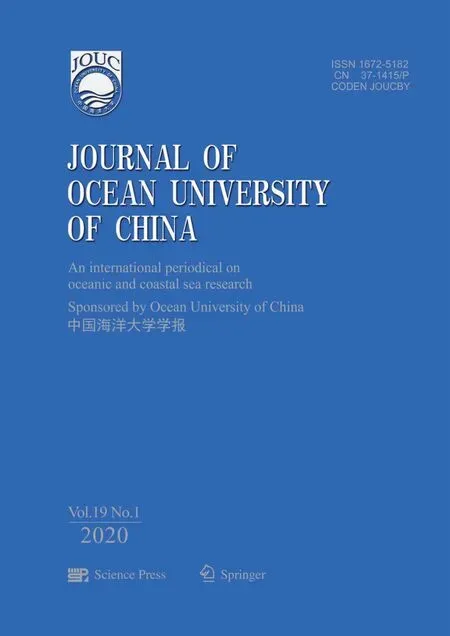 Journal of Ocean University of China2020年1期
Journal of Ocean University of China2020年1期
- Journal of Ocean University of China的其它文章
- Circulation and Heat Flux along the Western Boundary of the North Pacific
- System Reliability Analysis of an Offshore Jacket Platform
- The Mineral Composition and Sources of the Fine-Grained Sediments from the 49.6˚E Hydrothermal Field at the SWIR
- Research Progress of Seafloor Pockmarks in Spatio-Temporal Distribution and Classification
- Application of the Static Headland-Bay Beach Concept to a Sandy Beach: A New Elliptical Model
- Climatology of Wind-Seas and Swells in the China Seas from Wave Hindcast
